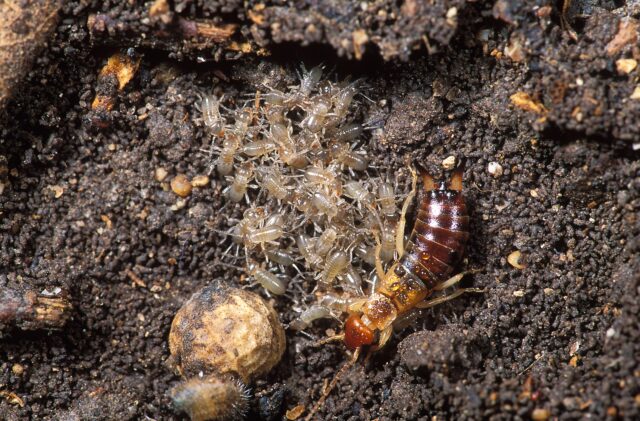Males that attempt to approach the nest are aggressively chased away, and with good reason, says Meunier. “Once, when we were in the field in Italy to collect earwigs, we found a male and a female together with a clutch of eggs. We were quite excited: ‘Wow, biparental care, cool!’ So we brought them to the lab. But what we actually observed was that the female was very stressed out, showing a lot of aggression towards the male, while the clutch size was continuously decreasing.”
Males, it turns out, love to snack on eggs, even ones that they fathered. To chase them off, females raise their abdomens to show off their pincers. If that’s not enough, they can use the pincers to hurt the male—even to cut him in half. (Scary as they look, the pincers can’t harm people at all, Meunier says.)
Earwigs can also spray each other with defensive secretions that may have antimicrobial properties, too. “They often use those secretions when meeting others,” says Meunier. “Maybe it also prevents the spread of disease.”
As far as scientists know, these secretions are harmless to humans. But because they contain quinone derivatives, which are also found in substances like henna, they have some quirky side effects. “When you get a lot of it on your hands,” Meunier says, “they’ll turn blue, like a bruise, and these marks can last all week.”
The secretions smell quite pleasant, says Kölliker. “When I had a visitor in the lab, I would sometimes pick up an earwig and hold it under their nose. It’s a very nice odor, actually, kind of an earthy smell.” Kölliker’s cat was less appreciative when he tried it on her: “She immediately backed off,” he says.

Overbearing moms
Surprisingly, Meunier’s recent work suggests that earwig offspring may pay a price for their mom’s protectiveness. In European earwigs and several other species, although the nymphs that emerge from eggs can feed on their own after a couple of days, mothers usually stay with them for a few weeks after they hatch. Yet, at least in the lab, that does not seem to enhance the nymphs’ chances of survival.




















+ There are no comments
Add yours